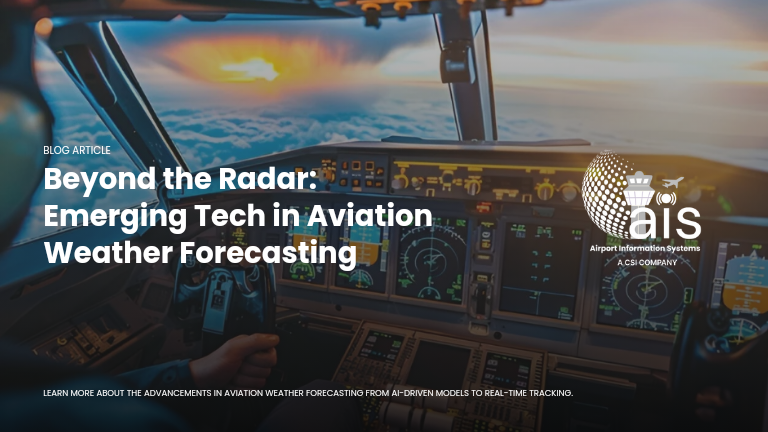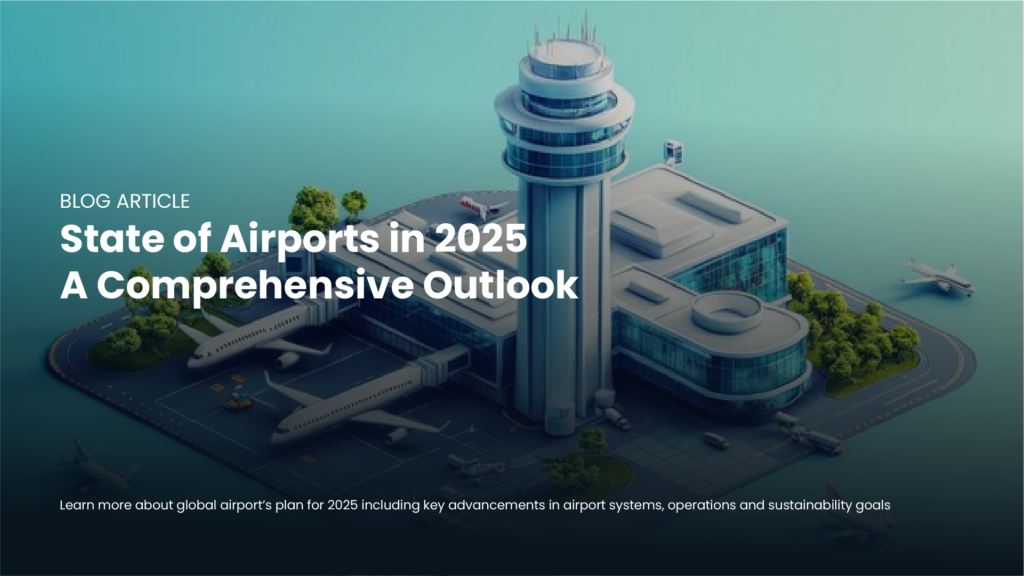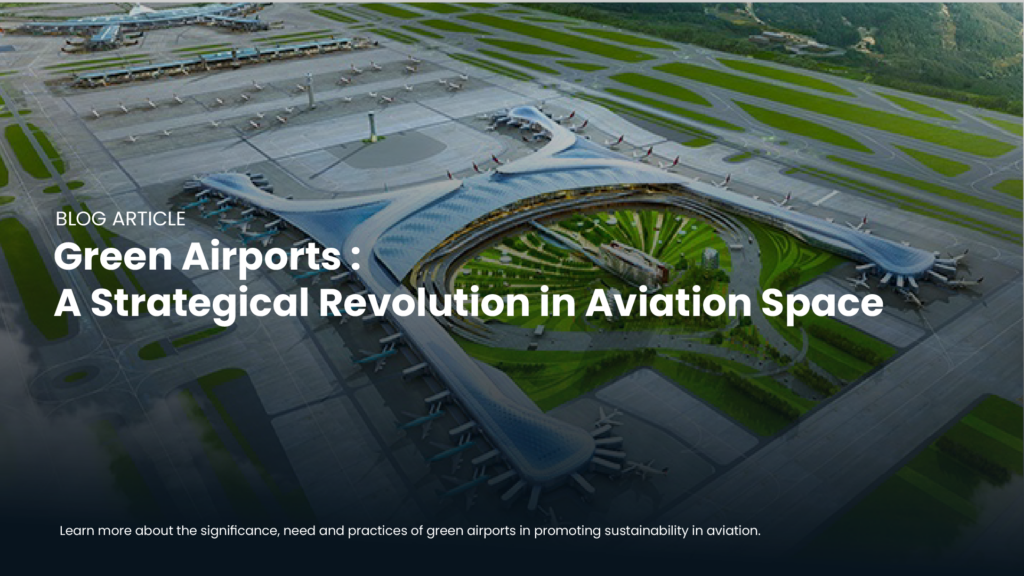Introduction
We’ve all been there: Refreshing the weather app on your phone a dozen times before a weekend trip, hoping for sunshine and clear skies. Now, picture airport managers and airlines doing the same, but for a journey carrying hundreds of passengers across vast distances. The stakes are much higher. The crucial importance of modern-day aviation weather forecasting is undeniable.
The crucial importance of modern-day aviation weather forecasting is undeniable.
But for aviation, the need goes beyond basic forecasts. Precise weather forecasting provides the critical information pilots, air traffic controllers, and airport personnel need to make informed decisions. From calculating optimal flight paths to determining safe landing procedures, every aspect of a flight hinges on accurate weather data. This unseen choreography keeps us safe in the skies.
Let’s dive a little deeper into this essential aspect of aviation and learn about its modern-day scenario.
Importance of Aviation Weather Forecasting & Current Scenario
Aviation weather forecasting is critical for maintaining safe and efficient air travel. With the increasing unpredictability of weather due to climate change, advancements in this field have become more important than ever.
Recent improvements in computing power have led to the development of high-resolution weather models. These models provide detailed forecasts that help predict localised weather phenomena like turbulence and icing conditions. By utilising data from ground observations, weather balloons, radar, and satellites, these models enhance the ability of pilots to adjust flight paths in real-time, ensuring passenger safety and comfort.
Current forecasting methods rely heavily on Numerical Weather Prediction (NWP) models. These complex computer programmes analyse vast amounts of atmospheric data to predict future conditions.
Several airlines are at the forefront of integrating advanced weather technologies into their operations:
- JetBlue: Partnered with Tomorrow.io to reduce weather-related delays and operational costs through AI-driven weather forecasting.
- Delta Airlines: Developed an application leveraging real-time weather data to set threat index alerts, significantly reducing turbulence-related incidents.
- United Airlines: Invested in micro-weather technology to provide hyper-localised forecasts, improving flight trajectories and fuel economy.
Similarly, airports have been actively working to integrate advanced weather technologies into their ground operations to enhance safety and efficiency. For instance:
- OpenRunway is an innovative online platform that provides site-specific weather forecasts for airports and airlines. This tool supports aviation professionals in making informed, weather-sensitive decisions, optimising operations, and enhancing safety.
- Advanced navigation tools and software, developed by NASA and the Met Office, are improving airport weather forecasting accuracy and reducing delays. Major airlines are implementing smart rerouting and rebooking strategies, perfecting the art of weather prediction.
- The FAAM Airborne Laboratory now shares live weather data with the Met Office during flights, enhancing forecast accuracy. This real-time data integration significantly improves the reliability and precision of weather predictions.
These partnerships and investments help airports manage ground operations more effectively, reducing delays and enhancing overall passenger safety and comfort.
Now, let’s look at some of these modern advancements in aviation weather forecasting.
Modern Advancements in Aviation Weather Forecasting
Advanced Turbulence Tracking Tools
One of the most exciting advancements is the rise of sophisticated turbulence-tracking tools. These systems utilise a combination of high-resolution satellite imagery, in-situ aircraft measurements, and advanced algorithms to identify and predict turbulence events with greater accuracy.
For instance, companies like Airbus offer solutions that leverage on-board sensors and real-time data to provide pilots with a clearer picture of potential turbulence zones.
Generative AI and Ensemble Forecasting
The power of Artificial Intelligence (AI) is also transforming weather forecasting. Generative AI models can analyse historical data and identify patterns that might be missed by traditional methods. This allows for the creation of more nuanced and accurate forecasts.
Ensemble forecasting, which combines predictions from multiple NWP models, is another powerful technique. By considering different model outputs, meteorologists can create a more robust and reliable forecast, reducing the risk of surprises.
Innovative Meteorological Instruments
The data used for weather forecasting is constantly evolving. Advanced ground-based instruments like Doppler lidar can provide more detailed information on wind shear, a major contributor to turbulence. Additionally, the increasing use of ADS-B (Automatic Dependent Surveillance-Broadcast) technology allows for real-time data collection from aircraft, providing valuable insights into atmospheric conditions at various altitudes.
Customisable Weather Solutions
The one-size-fits-all approach to weather forecasting is becoming obsolete.
Leading providers are offering customised solutions tailored to specific airport needs and surrounding airspace. These solutions take into account local geographical features and historical weather patterns to deliver hyper-localised forecasts, crucial for optimising airport operations.
Real-Time Weather Tracking and Alerts
Timely and actionable information is key for effective decision-making. Advanced weather tracking systems can now provide real-time data on developing weather patterns, allowing airports and airlines to react proactively to potential disruptions. Automated alert systems and stations can notify relevant personnel of impending storms, fog, or other hazardous conditions.
This enables proactive measures like rerouting flights, pre-deicing aircraft, or adjusting staffing levels to minimise delays and ensure passenger safety.
Challenges in Aviation Weather Forecasting
Despite significant technological advancements, aviation weather forecasting faces several persistent challenges.
Accurate forecasting relies on comprehensive data, but there are still gaps in data coverage, especially over oceans and remote areas. Satellites and ground-based sensors provide substantial information; however, the lack of real-time data in these regions can hinder the accuracy of forecasts.
Additionally, predicting localised weather events such as microbursts, sudden thunderstorms, and turbulence remains challenging. These phenomena occur on smaller scales and often develop rapidly, making timely warnings difficult for current models.
Integrating advanced forecasting technologies into existing aviation infrastructure also presents challenges, requiring significant investment and training. Airlines and airports must upgrade their systems and ensure staff are adequately trained to interpret and act on new data.
Moreover, the global nature of aviation necessitates international cooperation and standardisation, but differing regulations and standards across countries can complicate the implementation of uniform forecasting technologies and procedures.
Airport Weather Forecasting and ATC
Airport weather forecasting is a critical aspect of aviation that directly impacts the safety and efficiency of airport operations. With the increasing complexity and volume of air traffic, airports require precise and real-time weather data to manage ground operations, flight schedules, and passenger safety effectively.
Modern airport weather forecasting systems integrate advanced meteorological instruments, high-resolution weather models, and real-time data from various sources, including ground-based sensors and satellites. These systems provide detailed information on local weather conditions, such as wind speed and direction, visibility, temperature, and precipitation, which are crucial for safe takeoff and landing procedures.
One of the key components in airport weather forecasting is Air Traffic Control (ATC) data. ATC systems facilitate the flow of essential information, including flight plans, slot time requests, delays, and more. This data, typically entered in ICAO format and UTC time, includes details such as:
Aircraft Registration
Identifies the type of aircraft, retrieves relevant information, and allocates appropriate stands or air bridges.
Runway Used
Provides data for runway maintenance planning and statistical analysis.
Actual Time of Landing and Departure
Used for billing parking fees and updating flight information status.
Number of Circuits and Approaches
Recorded for billing and statistical purposes.
New Estimates of Arrival and Departure
Helps in planning and managing airspace efficiently.
This information is used for planning, airspace management, and overflight billing, ensuring that airport operations run smoothly and efficiently.
AIS’ advanced ATC solution integrates real-time weather data into the systems, allowing for more precise and proactive decision-making. This integration helps in managing unexpected weather conditions, optimising flight paths, and minimising delays, thereby enhancing overall airport efficiency and safety.
Conclusion
The future of aviation weather forecasting is as bright as a sunny day in Hawaii. Aviation weather forecasting is an indispensable aspect of modern air travel, ensuring safety and efficiency. Recent technological advancements have significantly enhanced forecasting capabilities.
High-resolution weather models and Numerical Weather Prediction (NWP) models provide detailed forecasts, aiding in predicting localised phenomena like turbulence and icing conditions. Modern advancements, including turbulence tracking tools, generative AI, ensemble forecasting, and innovative meteorological instruments, enable hyper-localised forecasts and real-time weather tracking, facilitating proactive decision-making.
By tackling challenges such as data limitations and the need for universal standardisation and by adopting new technologies, the aviation industry can enhance safety and efficiency. These improvements will lead to safer, more efficient, and weather resilience in air travel for everyone.


